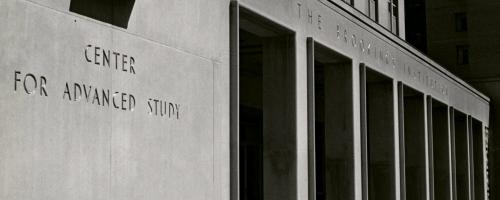The Trump administration has undertaken a series of deregulatory measures to address various challenges of the COVID-19 pandemic. The Brookings’ Center on Regulation and Markets is actively tracking these actions alongside the administration’s broader deregulatory agenda. We asked scholars from the Brookings Economic Studies Program for their thoughts on some of the most impactful COVID-related deregulations to date.
What do these rules entail, and how do the measures, temporary or otherwise, fit into the administration’s larger deregulatory agenda? Here’s what our scholars had to say:
EPA enforcement suspension
The Environmental Protection Agency’s (EPA) recent enforcement discretion policy temporarily relaxes the agency’s enforcement of environmental regulations on companies that are unable to comply owing to the COVID-19 pandemic. The agency writes that “[the] consequences of the pandemic may constrain the ability of regulated entities to perform routine compliance monitoring, integrity testing, sampling, laboratory analysis, training, and reporting or certification.” For example, potential worker shortages and travel and social distancing restrictions may reduce the availability of key staff and contractors and impair the ability of laboratories to analyze samples and provide results.
Adele Morris
EPA’s new policy requires facilities to keep records of their non-compliance, including its pandemic-related causes, but EPA does not require any public disclosures or reporting to EPA if it is “not reasonably practicable due to COVID-19.” Not surprisingly, the move is controversial. The Natural Resources Defense Council (NRDC) and other organizations have petitioned the EPA to require regulated facilities to monitor and report violations to EPA and state and local authorities. Petitioners also call for a public database of such violations. They argue that the people suffering the most from pollution are also especially vulnerable to COVID‐19 because they are more likely to suffer from chronic illnesses like diabetes and asthma. If people don’t have timely information about their exposures, they can’t protect themselves or pursue relief. Moreover, petitioners say, facilities are more likely to meet their pollution limits if they have to monitor and publicly report their performance.
While the unique challenges of COVID-19 naturally motivate some forbearance, EPA should not worsen the health crisis. A recent study shows that a small increase in long-term exposure to small particles in the air (PM 2.5) leads to a large increase in the COVID-19 death rate.
People suffering the most from pollution are also especially vulnerable to COVID‐19.
This finding underscores the importance of ongoing enforcement of air quality regulations, even during a pandemic. Where violations are unavoidable, there is a strong case to make them public promptly.
EPA should also make a plan for selective withdrawal of the enforcement discretion as soon as circumstances permit, wherever they permit. Although EPA says it plans to notify the public at least seven days prior to terminating its policy, this leaves open the possibility that the agency may wait until authorities issue the all-clear nationwide. The relaxation of social distancing is likely to be gradual and vary regionally, so EPA should develop a strategy to reinstate its usual enforcement as soon as possible in the relevant locations, industries, and facilities.
Finally, EPA should care that this measure comes in the context of recent deregulatory actions that are already damaging the agency’s reputation. For example, EPA has proposed to roll back the legal basis of its Mercury and Air Toxics Standards, in part on the basis of a benefit cost analysis that experts say is seriously flawed. The agency also weakened scheduled increases in fuel economy standards, which consumer advocates say will cost new car buyers over $3,000 over the life of their vehicle and significantly worsen greenhouse gas emissions. Researchers say EPA’s analysis supporting the rule was flawed, citing “pessimistic assumptions” that “likely overestimated compliance costs.” It’s no wonder if EPA’s credibility and motivation for its recent enforcement suspension are met with skepticism. A dose of transparency in the violations it allows during the pandemic would take just a little of the tarnish off.
Medicare coverage of telehealth visits
Paul Ginsburg
Historically, Medicare’s coverage of telehealth has been limited and has not included visits where the patient is at home. The situation with private insurance was similar. The Centers for Medicare and Medicaid Services (CMS) published an emergency rule that allows a major increase in coverage of telehealth visits for the duration of the public health emergency. This is likely to have a substantial impact because it addresses hesitancy on the part of both patients and clinicians and their staff to take the risks of COVID-19 infection associated with in-person encounters. So, this has the potential to limit the reduction in use of services and will be particularly valuable for those beneficiaries with chronic conditions, who not only can benefit substantially from management of the conditions but face higher COVID-19 risk than others through personal contact with clinicians and their staffs. Major private insurers have announced similar steps on a temporary basis.
Although clearly tied to this emergency, the experience of greater access to telehealth and more investment by medical practices to be able to deliver services in this manner is likely to affect subsequent decisions by CMS and private insurers about coverage of these services after the emergency. Substantial pressure might come from provider organizations, consumer advocates and the public to continue at least a portion of this. Analyses of the Medicare experience with wider access to telehealth should be able to inform these decisions.
Other Medicare and Medicaid provisions
Matthew Fiedler
CMS’s rule also included targeted changes or clarifications with limited implications beyond the COVID-19 pandemic. For example, the rule clarifies that patients who have been advised by a doctor to remain in their home, either because they may have COVID-19 or may be at particularly high risk if they contract COVID-19, will be considered “homebound” under Medicare’s rules and thus eligible for Medicare coverage of certain services delivered at home.
One exception is the rule’s change to allow non-physician clinicians, like nurse practitioners and physician assistants, to order home health care services under Medicaid. While the rule limits the policy to the duration of the COVID-19 public health emergency, it is easy to envision this policy becoming permanent. Indeed, CMS explicitly describes the change as a continuation of a broader effort to align Medicaid rules with Medicare coverage policies,
It is easy to envision this policy becoming permanent.
and expanding what tasks can be performed by non-physician practitioners has attracted support from experts and policymakers across the political spectrum (though also, in many cases, opposition from physician groups).
HIPAA telehealth exemptions
Christen Linke Young
The Department of Health and Human Services (HHS) has provided some relief from privacy rules that might otherwise limit providers’ ability to offer telehealth services. Specifically, HHS announced it will not take enforcement action for violation of HIPAA rules against providers that are acting in good faith to deliver telehealth care during the pandemic public health emergency. Under normal rules, the communication technology used for telehealth services must comply with a series of privacy standards, which generally prevent the use of common videoconferencing tools like FaceTime or Zoom.
However, HHS is allowing providers to use these popular programs for telehealth without fear of penalties for violating HIPAA. As a short-term policy to facilitate widespread availability of telehealth services during a pandemic, these rules represent a reasonable weighting of risk. But as the health care system returns to normal, reinstating the HIPAA privacy standards will best ensure protection of sensitive information, though HHS may find it appropriate to revisit some of the technical specifications to continue to facilitate telehealth adoption.
Relaxed supplementary leverage ratio for banks
Nellie Liang
On April 1, 2020, the Federal Reserve Board announced a temporary change to its supplementary leverage ratio rule that generally applies to financial institutions with more than $250 billion in total consolidated assets. The temporary change would permit financial institutions to exclude U.S. Treasury securities and deposits at Federal Reserve Banks from the total leverage exposure in the calculation of the rule. The Federal Reserve estimates that this temporary change would reduce the amount of required tier 1 capital by $76 billion at holding companies. The change will be in effect until March 31, 2021.
The supplementary leverage ratio is measured by common equity capital relative to total leverage exposure and is viewed as a backstop to risk-weighted capital requirements. Because it does not differentiate the amount of capital by exposure type, the supplementary leverage ratio can limit bank holding companies’ willingness to own Treasuries and act as a market-maker. In addition, reserves (deposits at the Fed) in the banking system are increasing with the Federal Reserve’s purchases of government securities, and bank balance sheets are growing as customers are drawing on credit lines and increasing deposits.
This temporary change likely will alleviate stresses in Treasury market functioning.
This temporary change is significant, and likely will alleviate stresses in Treasury market functioning and reduce balance sheet pressures to pull back on credit. Some investors, however, have raised concerns about whether the banks will remain sufficiently strong a year from now in light of the relaxation of capital requirements and the significant possibility that the economy will not have yet recovered. It is important for financial stability that the Fed monitor and supervise banks to ensure the temporary change is used for credit provision, rather than to increase capital distributions, as they stated they would in the interim rule.
Paycheck Protection (loan) Program for small businesses
Joshua Gotbaum
The Small Business Administration (SBA) operates an Economic Injury Development Loan (EIDL) program through private financial institutions offering low interest loans both to small businesses and nonprofits affected by natural disasters. In response to COVID, major changes were legislated. At first, the EIDL program was amended to provide for immediate $10,000 grants directly from the Treasury, rather than financial intermediaries. Then, in the CARES Act, the SBA’s basic 7(a) loan program was dramatically expanded to create the Paycheck Protection Program (PPP), a 1% loan for businesses and nonprofits sized to cover 2 ½ months of payroll, forgiven (i.e., become in effect a grant) if used to maintain employment, rent, and other fixed obligations.
PPP implementing guidance was issued on an emergency final basis. The most significant issues related to the procedures financial institutions must follow in processing PPP loans: generally, financial institutions could rely on certifications from borrowers, but had to complete “know your customer” anti-money-laundering reviews. As a result, although loan applications were described by SBA as “first come, first served,” financial institutions favored their existing borrowers and largest customers. Legislation a few weeks later allocated $60 billion to smaller financial institutions, in the hope that smaller businesses would get PPP loans.[1] The more sensible regulatory move would have been both to remove the “know your customer” requirement and impose a requirement proscribing any preference for current bank customers, or to bypass the loan structure entirely and use the tax system to subsidize wages directly, the approach taken in the UK and Germany.
The most important challenge for the PPP, however, is that the law has no requirement mandating a business keep or rehire its employees. In fact, it allowed loans to be forgiven if laid-off employees were rehired by the end of June 2020; SBA/Treasury closed this loophole in the implementing regulation by requiring that 75% of the loan had to be used for payroll in order to be forgiven. However, the basic structural flaw remains. SBA/Treasury also issued regulations resolving some issues whether the components of “affiliated organizations” may be considered separately as “small businesses.”
[1] The Paycheck Protection & Healthcare Enforcement Act, signed April 24, 2020, essentially doubled funding both for PPP and the EIDL grant programs and made agricultural businesses eligible for EIDL loans and grants.












Commentary
6 COVID-related deregulations to watch
April 30, 2020